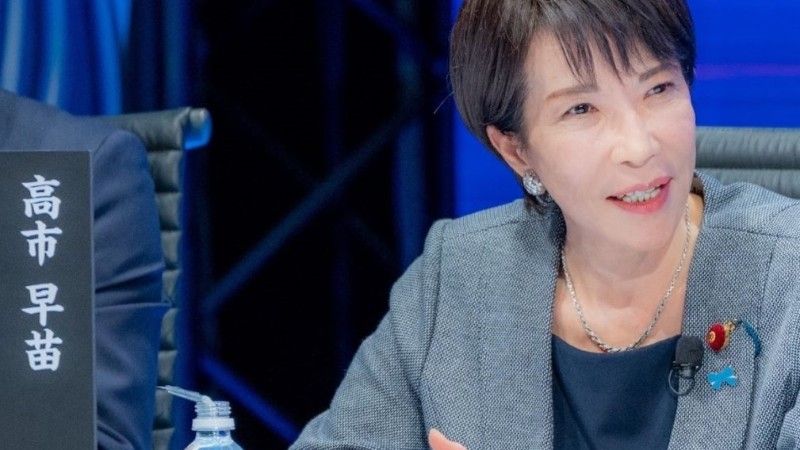
Photo. Sanae Takaichi/X
Copy link
Send email
The new prime minister of Japan regards cooperation with the United States as a pillar of her country’s foreign and security policy. She will seek to deepen alliance cooperation, but faces many challenges. The first is further negotiating a trade agreement with the United States, Dr. Oskar Pietrewicz (PISM) told Defence24.
Will the groundbreaking election of Sanae Takaichi as head of the Japanese government (the first female prime minister in history) also lead to significant changes in Tokyo’s foreign and defence policy? We discuss this in an interview conducted by Michał Górski with Dr. Oskar Pietrewicz, an analyst at the Polish Institute of International Affairs.
Michał Górski, Defence24: What can we expect from the new prime minister, Sanae Takaichi, in terms of Japan’s foreign policy? Compared with her predecessors, should we expect a major change or rather a certain continuity?
Dr. Oskar Pietrewicz, Polish Institute of International Affairs: Since Prime Minister Shinzo Abe’s terms (2006–2007 and 2012–2020), Japan has pursued a relatively coherent foreign policy that emphasizes tightening cooperation with the United States and responding to the growing challenges and threats from China. It has also intensified cooperation with regional states under the concept of a Free and Open Indo-Pacific and has expanded contacts with NATO. Abe’s successors — Yoshihide Suga, Fumio Kishida and Shigeru Ishiba — have, in principle, continued this direction in foreign policy. The same will be true for Sanae Takaichi, although her personal views — she is regarded as a „hawk” on China — may translate into increased tensions in Japan–China relations. Another source of friction with the People’s Republic of China, and also with South Korea, could be the new prime minister’s controversial views on Japan’s history, including downplaying its wartime crimes from World War II. At the same time, the appointment of Toshimitsu Motegi as foreign minister, who has previously held that office, suggests the new Japanese government is prepared to continue the foreign policy of recent years.
Do Takaichi’s election, her pledge to strengthen the Japan Self-Defense Forces, and the media discussions about relaxing the „Three Non-Nuclear Principles” that have been in place since 1967 indicate that Japan is heading for deep constitutional change and a departure from pacifist policy?
First of all, the Takaichi cabinet will be a minority government, which will make it difficult to introduce legislative changes across all areas, including defense and security. Constitutional changes would require a two-thirds majority in both houses of parliament, and the current government does not have that. It should also be noted that for years Japan has, in practice, not followed a strictly pacifist policy — it has made significant changes such as a more liberal interpretation of the pacifist provisions of the constitution and has amended major strategic documents like the National Security Strategy. Japan is increasingly open to defense cooperation not only with the U.S. but also with regional countries such as Australia and the Philippines. The Takaichi government may, however, try to modify further regulations, including seeking to lift restrictions on the export of Japanese weaponry. Changes in this area have been blocked by Komeito — the Liberal Democratic Party’s coalition partner. Perhaps in the new political configuration, with support from the right-wing Nippon Ishin no Kai, Takaichi will be able to implement these changes.
From time to time the media float the idea of an „Asian NATO,” i.e., a Pacific Defence Pact (the U.S., Australia, Japan and the Philippines). After the recent changes in Japan, is such an alliance any closer?
The idea of an „Asian NATO” was presented more than a year ago by Prime Minister Shigeru Ishiba, but it did not receive an enthusiastic response either among Japanese elites or Japan’s foreign partners. Above all, the concept was very vague, as it did not specify the scope of obligations for potential participants in a multilateral alliance. Moreover, implementing this idea would risk an increase in tensions with China, something most Asian and Pacific countries try to avoid despite significant problems in their relations with the People’s Republic. Rather than pursuing a formalized multilateral alliance, Japan will likely deepen defense cooperation with Australia and the Philippines, which it has been doing for several years. The challenge will remain the U.S. attitude toward maintaining and deepening multilateral cooperation with allies in the Pacific.
You touched on Japan-U.S. relations. What might cooperation between Japan and the United States look like now?
Takaichi regards cooperation with the U.S. as a pillar of Japan’s foreign and security policy. She will seek to tighten alliance cooperation, but faces many challenges. The first is further negotiation of a trade agreement with the U.S. Japanese business, including the automotive sector, is very unhappy about the retention of high tariffs (15%) despite declared investments in the U.S. amounting to as much as $550 billion. Takaichi will try to renegotiate the current terms of the agreement to better reflect the interests of Japanese industry. On security issues, the Trump administration will certainly expect Japan to increase defence spending (to reach 2% of GDP by 2027) and to increase the costs of hosting American troops. It is possible that, to build the best possible relationship with Trump, Takaichi will appeal to close ties with Abe, who was one of the U.S. president’s more important foreign partners during his first term.
Dr. Oskar Pietrewicz is an analyst at PISM in the Asia and Pacific program, focusing on security in East Asia, particularly the Korean Peninsula. He is the author of the books „The Dispute Over Korea: The Role of the U.S. and China in Shaping International Security on the Korean Peninsula” and „A Shrimp Among Whales: The Korean Peninsula in the Policy of Great Powers”.

AloJapan.com